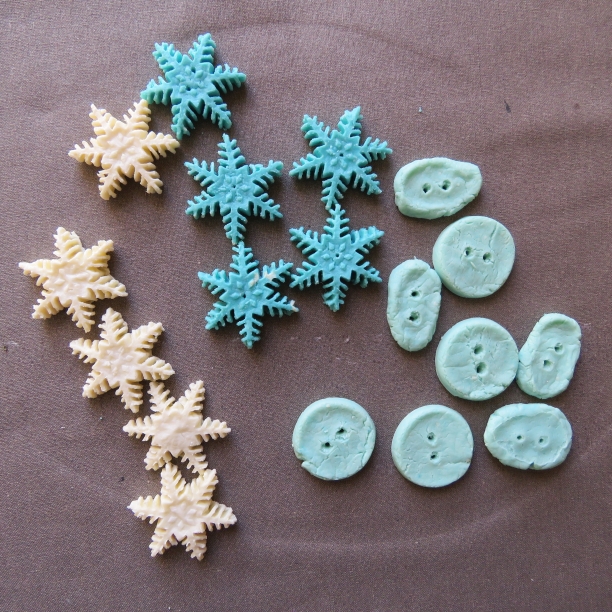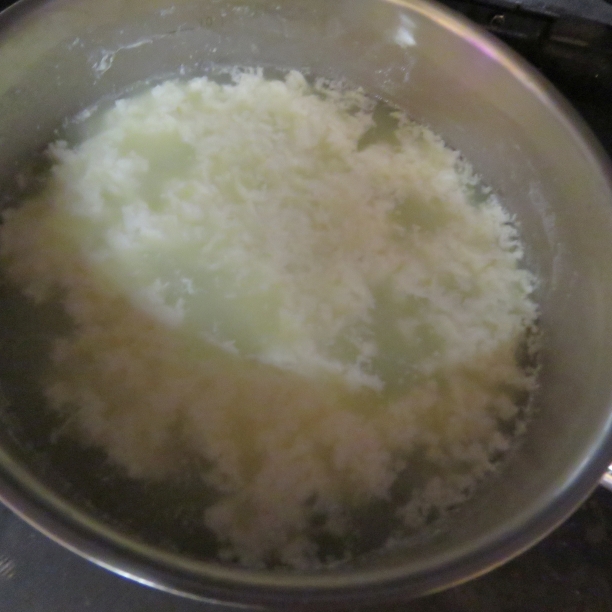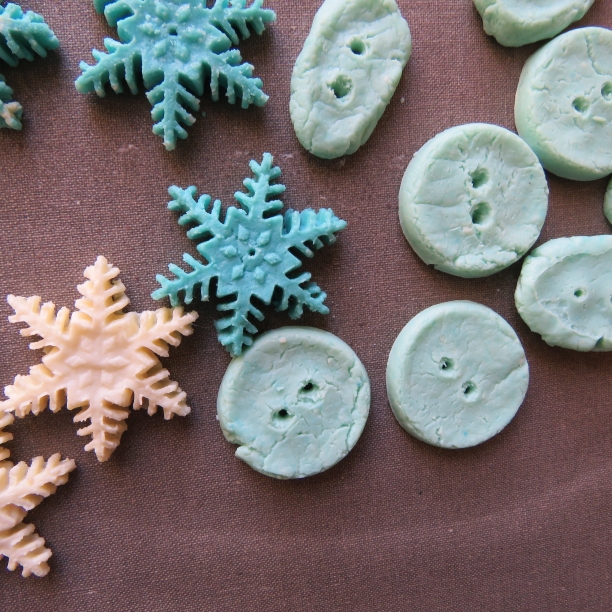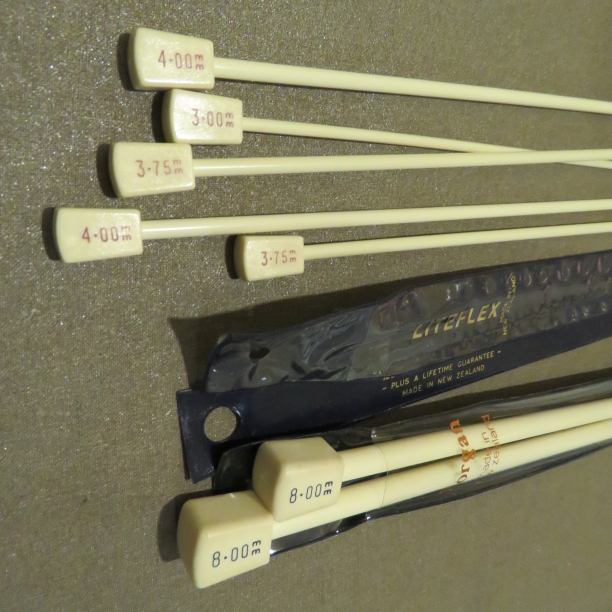Making buttons from milk plastic

During the week I happened to see a homeschooling family’s experiments making buttons from milk. Since my children are still at home, we gave it a try. It was a big hit!
Milk plastic, or casein plastic, is something I’ve vaguely heard of, but it was very common from about 1900 to WW2 and was called Galalith, Erinoid, Lactoid or other names. It was used for small things such as buttons, buckles, combs, jewelry, toothbrush handles, fountain pens and knitting needles. The plastic could be dyed any colour including imitation horn and tortoiseshell, and could also be polished. After the war, petroleum-based plastics came into wide use, replacing casein plastic.
We looked up some kids science websites and Youtube tutorials for how to do it (there are lots!) and it’s pretty simple.
We heated 1 cup of milk and 4 teaspoons of vinegar until it separated (took about 1.5 minutes).

This only makes enough for one child to use, so we quickly made another lot.
Then it gets poured through a strainer to get the solids.

We squeezed it with paper towel to get rid of all the moisture – it has to be dry enough so your hands don’t get wet when you work it.
It starts off lumpy like cottage cheese but gets smoother and less crumbly as it cools down and you knead it with your hands. Gets easier to mold too.
(Apparently if you now soak the curd in vinegar for an hour it gets smoother and whiter. Something to try next time.)
The memories of play dough and toddlers came flooding back….
I coloured mine with blue food colouring which came out light green since the curds are yellowy. I made buttons by flattening it out and cutting circles using an icing nozzle. I used the blunt end of a wooden skewer to make the holes. (The buttons cracked as they dried – maybe we dried them too quickly – and now they look very amateur.)

The others made star shapes with an icing cutter we used for a Frozen birthday cake. Theirs came out surprisingly well. They said mine looked like after-dinner mints.

We heard it takes about a week for the shapes to air-dry, but we have an oven with a warming bay, so we left them in there for the rest of the afternoon. Before I went to bed I turned the shapes over and by morning they were fairly, but not 100%, dry. I made the holes in the buttons a bit bigger with an awl.
We will leave them to dry naturally for the rest of the week and see how hard they get. In manufacturing, casein plastic is washed in a formaldehyde solution to harden it, but obviously we won’t be doing that!

Educational part: milk contains molecules of a protein called casein. When we heat milk and add an acid (which doesn’t have to be vinegar btw) the molecules unfold and form long regular chains called a polymer. The polymer can be molded and shaped which makes it a plastic. It’s called casein plastic or milk plastic because of the type of molecules that created it.
So, does anyone still manufacture casein plastic? I couldn’t find anyone but didn’t spend much time investigating. I have some casein knitting needles from my late grandma which she bought in the 1990s. They’re made in New Zealand. She said they were wonderful to knit with – far kinder on the wrists than metal needles and eventually she replaced all her needles with casein ones.

Swallow brand casein knitting needles were made in Australia – are they still being made?
I wondered if we had any casein buttons in the button jar, but I’m not sure how to tell the difference between casein plastic and other plastic. Masterton in New Zealand made casein buttons up until 2004.
QMilch or QMilk is a fabric made from milk, which you can read about here and here.
Have you made or used objects from casein plastic? Please tell us about it in the comments.
Cheers!
How absolutely amazing! I had no idea about any of this – May just try it one day.
Please report back how the natural drying went.
Thank you ,
Karin
We had no idea either. The shapes have been air-drying for 3 days now and they’re much harder.
Wow!!! Never heard of Casein needles or buttons. A great research explorations by your home team. Hope to hear more on Casein products and solutions to help eco friendly fashion designing.
It was really interesting but we haven’t taken it further. My children have gone back to school now.
You’re right, it would be a great product for eco friendly fashion designers.
Never heard of this before. It’s amazing! Maybe they’d be more biodegradable than other polymers?
It seems to be biodegradable, but I’m no chemist. Is kind of amazing though!
That is amazing! Milk protein curdled out like that is paneer – so you basically made buttons with paneer!!!! Casein is really a miracle protein!
Haha! Edible buttons!
I have casein knitting needles and lots of buttons but I’d love to have a go at making my own! I’m definitely going to try this – thanks Liz!
If you dig a bit deeper around the internet, you could improve on our efforts. We did the “kid’s science experiment” version but I believe it could be taken through a few more processes for a better finish. We just rolled ours out like biscuit dough but I think a mould would give an improved button. I will be interested to see yours!
Thanks Liz, I’m going to start some research!
It’s a fascinating substance. As an example of what can be done with it, this UK company is making beautiful guitar picks out of Galalith and their website is well worth having a look at. They are expensive, but I bought a couple on a whim and when I received them, it was like holding a piece of jewellery. They’re absolutely beautiful and practical as well and believe it or not drastically improve the tone of the instrument.
Thank you, I hadn’t thought about casein plastic in the musical world. Interesting that it changes the tone of the instrument. Thanks for commenting 🙂
Thanks Liz. I meant to include the website for the guitar picks in case anyone is interested in looking at the designs…… or are encouraged to take up the guitar as another hobby:) https://hawkpicks.co.uk/
Thanks for adding the link Anthony. After your first comment I googled it and read a whole lot of interesting stuff – sounds like they’re not cheap but totally worth it.
Codelite buttons are now being made in England. https://courtneyandco.uk/materials/codelite.php
Thanks for the link Karen – I was really hoping that someone would revive this.